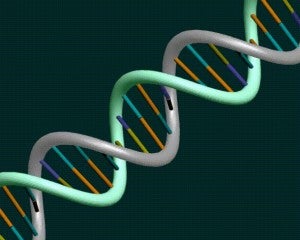
A doctor has some tried and true methods of helping her diagnose a disease: examining the lymph nodes, taking your temperature, that whole “turn your head and cough” thing. Now, we need to add one more: whole genome sequencing. Researchers at Yale have sequenced the genome of a patient in order to diagnose his condition, reportedly for the first time. Richard Lifton and his team examined the protein encoding portion of an infant’s DNA to determine whether or not he had Bartter’s syndrome (he didn’t). Though still too expensive to use in everyday clinical work, Lifton has shown that whole genome analysis is an effective and relatively quick method to diagnose some diseases. We’re going to be seeing a lot more of this.
The costs of whole genome sequencing has been falling since the completion of the Human Genome Project. Industry leaders Complete Genomics and Illumina are pushing prices below $50,000 per genome and we could see it drop to $1000 within the next year. Cheap genome sequencing will open up new avenues of diagnosis, but could also allow individuals greater insight into which diseases they should be on the lookout for. IBM announced that it will use silicon chip technology to speed up whole genome sequencing, and we’ve already seen a handheld device that finds special gene variations using CMOS components. As genetic analysis gets faster and cheaper, the medical system will have to adjust to take advantage of the new information, hopefully with amazing results.
Lifton’s analysis of the five month old infant’s genome came at the request of a Turkish doctor who feared the child’s dehydration and lack of weight gain was due to Bartter’s which often leads to fatal kidney disease. In just ten days, the Yale team was able to determine that the baby actually had a mutation in a gene that caused intestinal problems due to congenital chloride diarrhea. Not only that, but they discovered that five other cases referred to them for Bartter’s were due to similar genetic mutation.
While the sequencing used in these tests spanned the entire genome of the patients, only the portions corresponding to protein coding were examined. The protein coding portion of the genome, called the exome, is just 1% of your DNA but 85% of all clinically important mutations occur there. Focusing on the exome allowed Lifton’s team to cut associated costs to one-tenth of what they would be if every gene had to be examined. Price reductions like this could allow genetic analysis to become a common tool in clinical diagnose much sooner than it would otherwise.
So here we have two exciting trends that could improve healthcare: dropping costs in whole genome sequencing, and finding ways to cut prices further by focusing on specific genes. These trends are likely to work in your favor: the genetic analysis that may warn you of high risks of cancer, heart disease, etc could become commonplace in your doctor’s office in the next five to ten years rather than in the next twenty five. While some worry about the lack of privacy, or the institutional prejudice, that could arise from easily sequencing someone’s DNA, I tend to focus on the better medical care that’s almost certain to arise. The more you know about how your body works, the more you can do to keep it healthy.
[photo credit: Yale University]


